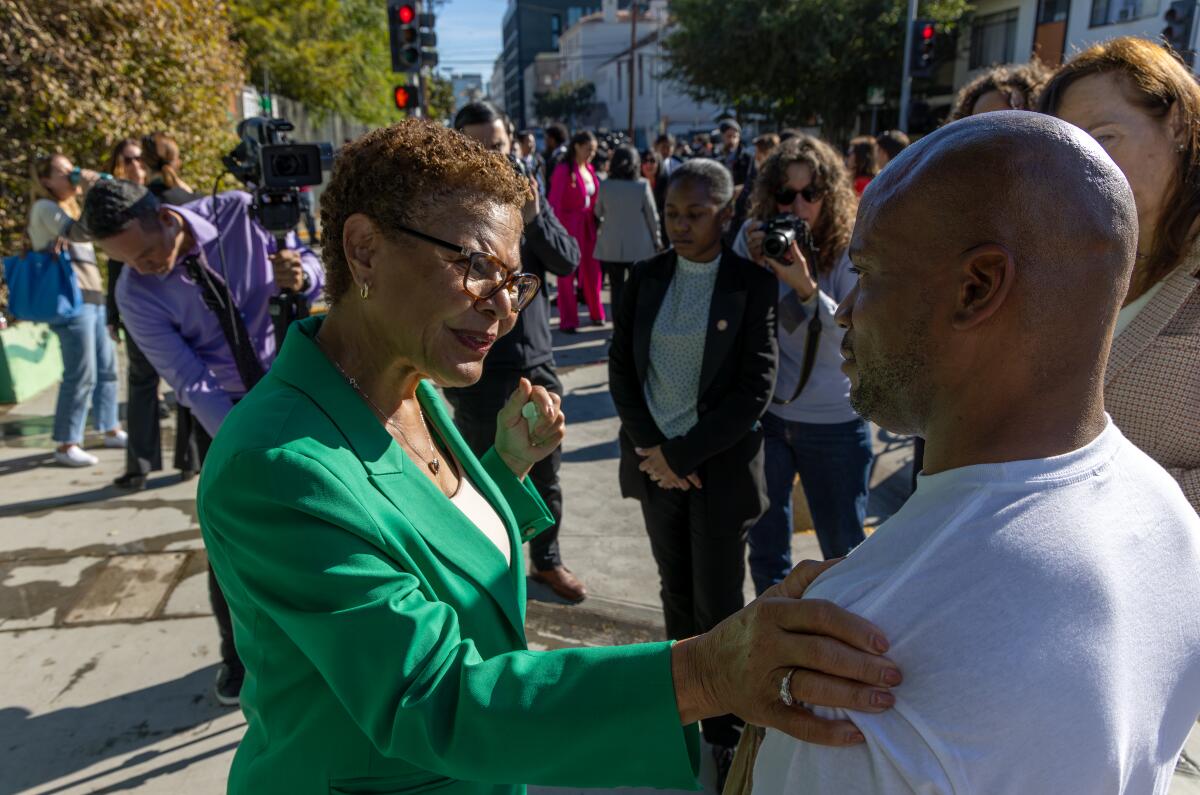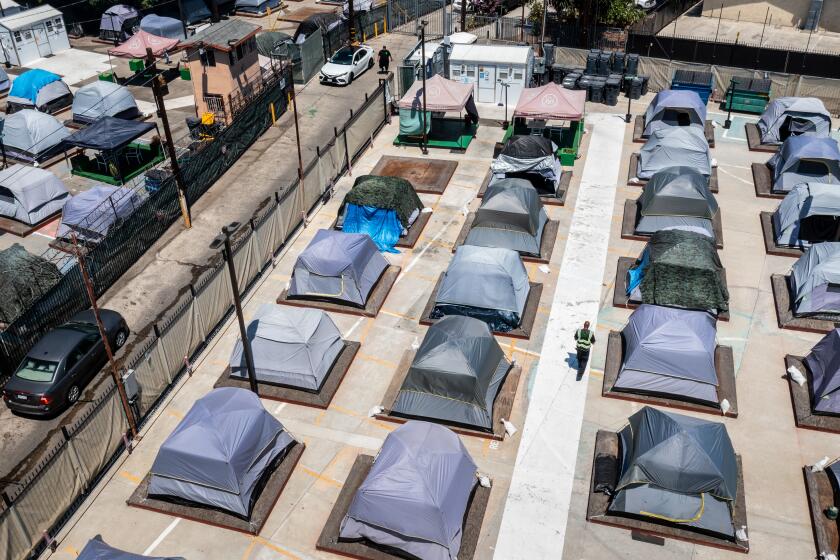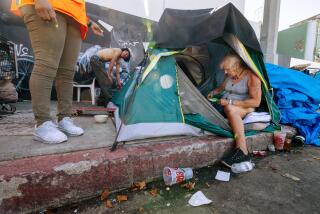Bass says L.A. has put 21,000 homeless people into interim housing. Hereâs what that means

Over the past year, Los Angeles city and county agencies have moved more than 21,000 unhoused Angelenos into interim housing â motel rooms, shelter beds, tiny home villages and an assortment of other sites, Mayor Karen Bass said Wednesday.
Bass, marking the end of her first year in citywide office, said the figure showed the strides that her administration, working closely with many other government officials, have made in getting homeless residents off the street and under a roof.
âWe have shaken up the entire system, a system that was not driven by outcomes,â Bass said during a 90-minute press briefing.
How far those efforts will go toward addressing the cityâs overall homelessness crisis is still unclear.
A city audit found that quality issues with the Los Angeles Homeless Services Authorityâs interim housing data make it ânearly impossibleâ to find available shelter beds.
Bass said the strategies spearheaded by her administration have resulted in a reduction in the number of sidewalk encampments across the city. However, those efforts may not translate into a reduction in the overall number of homeless Angelenos.
For one thing, residents who are placed into interim housing facilities are defined as homeless, albeit sheltered, in the countyâs yearly homeless count.
In addition, the city could see its homelessness numbers increase if evictions push a substantial number of residents onto the street, Bass said.
âI will continue to say this: Iâm really worried about the inflowâ of unhoused residents, she said. âEspecially because of the evictions, especially because of the end of COVIDâ tenant protection measures.
The city had more than 46,000 unhoused residents in January â a 10% increase, according to the regionâs annual homelessness count. That count took place shortly after Bass took office.
Last year, while campaigning for mayor, Bass said she would move 17,000 people indoors during her first year in office. During the final year of former Mayor Eric Garcettiâs administration, 16,931 homeless residents made their way into interim housing, according to numbers provided by Bassâ team.
Under Bass, the city has increased the number of interim housing placements by 28%. At the same time, a significant number of people also have been leaving those sites.
Of the nearly 22,000 moved into interim housing this year, about 7,100 people went back to the street, were reunited with family, went into medical facilities, were incarcerated, died or disappeared from the system, according to figures provided by LAHSA, the Los Angeles Homeless Services Authority.
Bass and LAHSA officials have portrayed their interim housing work as part of a larger shift, away from the idea that homeless Angelenos should not be moved off the street until there is an apartment waiting for them. Waiting for the completion of permanent housing would leave homeless residents vulnerable to illness, crime, hunger, and exposure to heat and cold, those officials said.
Leaving people on the street also results in costly emergency room visits, hospital stays, emergency response calls and court cases, homeless services officials say.
âWhy would we keep people unsheltered in tents, versus sheltered and in interim [housing]?â said Va Lecia Adams Kellum, the top executive at the homeless services authority. âIt is expensive, yes it is. But itâs more expensive for people to stay unsheltered.â
Bass has been trying to break the logjam that is preventing homeless residents from making their way out of interim housing and into permanent homes. She has pursued an array of policies aimed at speeding up the approval and construction of affordable housing.
Get the lowdown on L.A. politics
Sign up for our L.A. City Hall newsletter to get weekly insights, scoops and analysis.
You may occasionally receive promotional content from the Los Angeles Times.
Over the past year, 3,551 unhoused residents were moved into permanent housing, due in part to the completion of projects financed in part by Proposition HHH, a property tax increase approved in 2016. At the same time, real estate developers have proposed more than 9,000 units in 100% affordable housing projects that are participating in a fast-track approval program initiated by Bass.
Although those efforts are showing results, Bass has concluded that many sheltered homeless residents will have to stay in interim housing for extended periods of time.
The mayor said that when she first took office, she assumed the length of a stay at an interim housing site would last three to six months.
âThe reality is ... interim is really going to mean more like a year-and-a-half to two years,â she said.
On Wednesday, Bass and her team also touted their work in ensuring that 7,717 unhoused residents used housing vouchers to come indoors this year, up from 5,223 in 2022.
For now, city officials cannot say how many of the people who were placed in interim housing also made use of housing vouchers. The assumption is there is some overlap between those sets of data.
LAHSA officials said they are working to improve data collection at their agency.
Meanwhile, UCLA professor of law emeritus Gary Blasi, who has repeatedly sued the city over its handling of homelessness, gave the mayor favorable marks for her work on that issue.
âI would say that Mayor Bass has accomplished more on the problem of homelessness in her first year than any mayor in the last 40 years,â said Blasi, former president for the National Coalition for the Homeless. âWhat is tragic is that it has taken 40 years to get this far.â
More to Read
Sign up for Essential California
The most important California stories and recommendations in your inbox every morning.
You may occasionally receive promotional content from the Los Angeles Times.












